
The inevitability of War,
|

1 January 1945,
Operation 'Bodenplatte'. In Europe Allied air forces operating from airfields in Holland,
Belgium and northern France are surprised by a sudden attack by more than 800 diverse aircraft
which the Luftwaffe has assembled from all possible locations, despite their loss of 50 many in
recent weeks. The motley collection is flown by novices who are led to their targets by the few
remaining skilled pilots. The Allies lose 300 aircraft but can replace these quickly;
the Luftwaffe count is just over 200. These, and their pilots, are irreplaceable and the
action has rendered the Luftwaffe almost powerless in the west.
Communistic "Comité of Lublin" provisional Government in Polen,
for the time being.
3 January 1945,
British troops land at Akyab (Gulf of Bengalen).
In Burma the Japanese do little to prevent an Allied landing on Akyab Island in the Arakan.
Inland British troops are advancing towards the Irrawaddy.
In the Pacific the Japanese launch frantic attacks against the US fleet heading for the Philippines,
but only superficial damage by Kamikazes is caused.
4 January 1945,
(till 8 Januari).
Heavy 'Kamikaze' attacks on the USA Landings Fleet on it's way to the
"Gulf of Lingayen"; 1 Carrier and 2 minesweepers sunk, 2 convoy
Carrier and other ships heavily damage (too 2 Battlecruisers). Task Force 38 join the fray and send their aircraft against Japanese airfields operating the Kamikazes.

|
The F4U-1d Corsair was a carried-based fighter in continuous
production longer then any other World War II-era aircraft. It was a large, fast , powerful
fighter with several .50 caliber machine guns, 5-inch rockets and could carry several 5001b bombs.
|
6 January 1945,
Task Force 38 join the fray and send their aircraft against Japanese airfields operating the Kamikazes.
9 January 1945,
Lingayen landings: In the Pacific U.S. forces land on Luzon, the Philippines and make progres
because the japanese commander, General Yamashita, has decided not to fight his battle here.
He has more than a quater of a million men at various locations. Continued Japanese attacks from the air and sea
are irritant but cause no substantial damage. The US beachheads are in Lingayen Gulf where the Japanese had landed 3 years before.
Allied inflict a heavy defeat upon Germany.
16 January 1945,
End of the Ardennes offensive. American and British troops meet at Houffalize.
Losses: 32.000 soldiers (24.000 Germans and 8.000 Allied), 2500 civilians;
1300 tanks, 1280 planes and 6.000 vehicles.

|
The M24Chaffee (named for Gen. Adna Chaffee, the Father of the US
Armored Force) was out fitted with an anti-aircaft turret.At least 2 of these units
saw action at the Battle of the Bulge. The Chaffee carried a 75 mm gun, which was not
strong enough to penetrate the armor of German Panther tanks.
|
Tanks at Operation "Herbstnebel". | |
| Allied | German |
Sherman, 35 ton
Cobra-King, 40 ton
Pershing, 45 ton | Panther, 30 ton
Tiger, 60 ton
Köningtiger, 75 ton |
| |
| |
17 January 1945,
Russian troops capture Warsaw, Poland.
20 January 1945,
The Provisional Government of Hungary signs an
armistice with the Allies.
22 January 1945,
The dutch factory which manufactures the liquid oxygen
to fuel V-2 rockets is destroyed by Spitfires after its location has been traced by SOE agents.
23 January 1945,
(till 8 May). Evacuation transports of 2.000.000 Germans from East- and
West Pruisen.
27 January 1945,
In Burma the Ledo Road to China is finally cleared and the advance to Lashio and Mandalay can be faster.
Soviet Forces capture Lithuania.
27 January 1945,
Red Army liberates Auschwitz, finds convincing
evidence of SS atrocities of the Holocaust.
Concentration camps,
Concentration camps were established in Germany shortly after Hitler's assumption of power in 1933 as
places for anyone out of step with Nazism to be detained. Socialists, communists, blacks, gypsies, vagabonds,
trade unionists, and Jews were amongst those seen as undesirable.
The outbreak of war brought a radical change in the camp system. New concentration camps were set up
throughout occupied Europe to deal with the millions of captive foreign opponents of German domination. In
Poland extermination camps were established to implement the 'Final Solution,' the systematic killing of
more than six million Jews.
The concentration camps varied in size and function but in each there was no regard for human life. Many
were massive industrial complexes using the inmates as slaves. Disease, starvation, neglect, overwork,
added to the death toll of deliberate murders.
Joseph Mengele (1911- 1979?).
The notorious Auschwitz doctor in charge of racial experiments, 1943-1945.
To create a race of blue-eyed Aryans, he experimented on the living and the dead, specializing in twins,
dwarfs, hunchbacks and any physical oddity. Onto twins he grafted skin, bones or organs, and then made
comparative post-mortem autopsies. Experimented upon by a medical mediocrity, his victims died painful and totally pointless deaths. No information of medical value is known to have emerged from the tortures inflicted on those Mengele still
called his patients. To the camp he became known as `the Angel of Death' from his selection duties on
the entry ramp as transports arrived.
He escaped to Latin America after the war and became one of the most hunted of war criminals.
Confessions by his friends and family in 1985 led to the examination of the remains of a man drowned
in Brazil in 1979, which were judged to be those of Mengele.
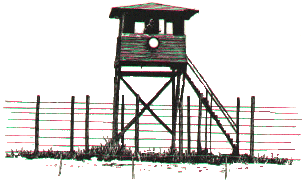
The wire with watch-tower
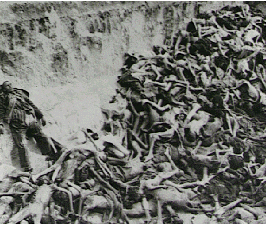
Huge trenches were dug and bodies just thrown into them in a concentration camp, most of whom had been starved and tortured to death.
These were the scenes after the liberation of the camps from the Germans.
| Estimate numbers of killed Jews at WW II in or on the way to Concentration Camps.
| | |
| Counties | Jews population at the begin of 1939 | Number of killed Jews |
| Norway | 2.000 | 1.000 |
| Denmark | 6.500 | 1.000 |
| Germany | 240.000 | 207.000 |
| Netherlands | 140.000 | 104.000 |
| Belgium | 90.000 | 50.000 |
| France | 270.000 | 70.000 |
| Italy | 50.000 | 17.000 |
| Baltic'S | 244.000 | 244.000 |
| Poland | 3.5 million | 3.3 million |
| Russia | 3.0 million | 420.000 |
| Austria | 60.000 | 53.000 |
| Tsjechoslowakia | 315.000 | 271.000 |
| Joegoslavia | 75.000 | 63.000 |
| Greece | 74.000 | 73.000 |
| Bulgaria | 50.000 | 3.000 |
| Romania | 800.000 | 370.000 |
| Hungaria | 400.000 | 200.000 |
31 Januari 1945,
Roosevelt (with 'Quincy') and Churchill meet at Malta.
Malta was used as a bomber base for raids against Italy and Lybia
(Wellingtons).
3 Februari,
U.S. Marines enter Manila, the Philippines.
Bomb attack of the USA Air-Force on Berlin with 1000 bombers.
4 February 1945,
(till 11 February). Roosevelt, Churchill and Stalin hold the Yalta
Conference ('The Big Three').
Capture of Belgium.
6 February 1945,
Soviet settle down at the other side of the river Oder.
9 February 1945,
6th American Army and 4 divisions land in the "Gulf of Lingayen" (Luzon).
10 February 1945,
The passenger liner General von Steuben is sunk by the Soviet submarine S13,
with onboard more than 6.000 passengers and which has sailed from Pilau the previous day.
300 passengers were saved, and Soviet claims that among those lost were elite officers,
SS men and Nazi Party officials cannot alter the fact that many refugees go down with the ship.
Ninety U.S. B-29 bombers raid Tokyo, Japan.
| Production of aircraft | | | | | | |
| Country | 1939 | 1940 | 1941 | 1942 | 1943 | 1944 |
| USA | 5.856 | 12.804 | 26.277 | 47.836 | 85.898 | 96.318 |
| USSR | 10.382 | 10.565 | 15.735 | 25.436 | 34.845 | 40.246 |
| UK | 7.940 | 15.049 | 20.094 | 23.672 | 26.263 | 26.461 |
| Germany | 8.295 | 10.826 | 11.424 | 15.288 | 25.094 | 39.275 |
| Japan | 4.467 | 4.768 | 5.088 | 8.861 | 16.393 | 28.180 |
| Italy | n.a | 3.257 | 3.503 | 2.818 | 967 | - |
| . | | | | | | |
13 February 1945,
Allied air offensive against German railway system. Dresden, Germany is burned down in an incendiary raid, 130.000 killed.
Capture of Boedapest (Ruins) by the Red Army after fight against German and Hungarian
troops; 49.000 Germans killed, 110.000 captive.
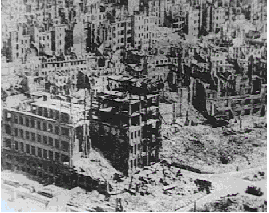
An aerial view of the damage done to the German city of Dresden by the intense Allied bombing on the night of 13/14 February 1945.
Dresden:
Location of a devastating air-raid in February 1945: Dresden burned for several days and nights and the number killed has never been
precisely known. In 1945 Dresden was thought to be the safest town in Germany, but with the January Russian offensive, refugees from the east were pouring in and, with the 26.000 Allied prisoners held there, the city was overcrowded and the parks used for camps. The Russians at the Allied conference in Yalta in February asked for air attacks on communication centres ahead of their advance. Dresden was selected. 13 February was Shrove Tuesday and many carnival parties were ending when the first attack by the RAF started. The Luftwaffe had few night-fighters deployed and the air-raid warnings were not given until too late. In two attacks that night, 786 RAF bombers dropped 2.647 tons of bombs. Fires raged throughout the centre of the city and the air-defence services were overwhelmed. On the morning of 14 February, 316 USAAF bombers struck again. The next day, Thursday 15 February another 211 USAAF planes came by day. There is little doubt that the object of the bombing was to create the firestorm phenomenon which had been accidentally achieved (with utterly devastating results) in the great Hamburg raid. Casualty estimates have since been a matter of argument.
The Dresden police are quoted as having given a first estimate of 18.000 dead, with an expectation of a greater number to be found on later counts; but since then there have been estimates as high as 130.000.
The Russians at first gave a low figure in reaction to German propaganda, but later found it useful to give the highest numbers as proof of ruthlessness in destroying one of Europe's most beautiful and defenceless cities.
The casualties were certainly high, probably as many as 70.000. The effectiveness of the raids may also be questioned for, in spite of
major dislocation, trains ran through Dresden on 15 February, two days after the first attack.
19 February 1945,
(till 26 March). US Marines divisions land on Iwo Jima ( 20 km²),
In the Pacific Iwo Jima is strategically and politically to both sides significant. The Americans need the island
as a fighter base (Mustangs P-51 fighters) for their Japanese raids (B-29's) and a relief base for damaged bombers.
On the first day some 30.000 marines getting ashore, the about 23.000 Japanese soldiers has prepared defences
but allows the landing to take place before opening fire.
Over the next two months 6.281 US soldiers are killed (in the first 2 days, 4000 US soldiers died), and 21.865 are wounded in
capturing the island from 23.000 defenders, 21.000 Japanese soldiers died.
The Pacific War
In the central Pacific, the Americans mounted a successful campaign of amphibious operations on the Japanese strongholds on the many island groups. However, rather than waste resources in frontal attacks, their strategy was to isolate the individual strongholds. The island of Iwo Jima was needed as a forward airfield for American fighters operating over Japan. The assault began in November 1944 with an enormous air-sea bombardment, the Marines landed on 19 February 1945 and after fierce fighting the island fell on 16 March.

23 February 1945,
A fire bomb test raid on Tokyo with 172 planes burns
one square mile, the most destructive raid on Japan to date.
23 February 1945,
U.S. Marines plant a U.S. flag on Mount Suribachi, Iwo
Jima.
Turkey and Egypt vote to join the Allies against Germany and Japan.
27 February 1945,
U.S. President Franklin D. Roosevelt hosts a gathering
aboard his cruiser. Those on hand include Haile Selassie of Ethiopia,
King Faruk of Egypt, and King Ibn Saud of Arabia. General de Gaulle
refuses to attend.
4 March 1945,
Finland declares war on Germany and Japan.
7 March 1945,
In the Pacific with the fall of Manila US advances continue to the south
of Luzon while elsewhere minor pockets of resistance are dealt with.
Allied forces capture Cologne, Germany.
In Yugoslavia Josip Broz Tito and his supporters emerge as the dominant partners in a government shared wîth the Royalists.
American passes the "Ludendorff-railbrigde" at Remagen with
Pershing tanks and a infantry company.
In a swiff advance by US III Corps units reaches the Remagen damaged Ludendorff Bridge
at Remagen and forces are across before it can be completely destroyed by the retreating Germans.
This considerable setback to German hopes of holding this point causes Hitler to sack von Rundstedt as CinC West.
Eisenhower's reaction to the bridge's capture: 'That bridge is worth its weight in gold.'

|
The T26 Pershing orginated with the T20 Medium tank, which was to be
eventual replacement for the Sherman in the approximately the same firepower and
armor protection as the Tiger I.The most famous action involving Pershings was the
capture on March 7th 1945 of the Luddendorff railway bridge in which four Pershings
played a leading role.Ironically, the Pershings never crossed the badly damaged
brigde as they were considered too heavy for it, instead they were ferried over five
days later the tank carried a 90 mm gun which could defeat all German tanks.
|
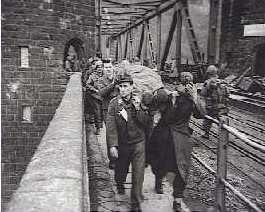
American troops with German prisoners on the bridge over the Rhine at Remagen.
9 March 1945,
In a massive air raid on Tokyo by 334 US B-29 Superfortresses 100.000 lose their lives, injuring 1,000,000, in
the firestorm created among the wood and paper-built houses.
The B-29s, stripped of guns for greater bomb load, carrying 2000
tons of incendiaries. 15.8 square miles of Tokyo burn.
22 March 1945,
10 days bombardment on Okinawa.
First-line combat aircraft in the Pacific war.
| _______________________________________________ |
|
|
| Date |
US Aircraft |
Japanese Aircraft |
| _________________________________________________ |
|
|
| Jan. 1943 |
3.537 |
3.200 |
| Jan. 1944 |
11.442 |
4.050 |
| Jan. 1945 |
17.976 |
4.600 |
| July 1945 |
21.908 |
4.100 |
| __________________________________________________ |
|
|
24-25 March 1945,
Operation Varsity, the airborne support for the 9th US and 2th British Armies' crossing of the Rhein.
On the morning of 24 March 1945, an enormous air armada crossed the River Rhein near Wesel in Western Germany.
The column, two-and-a-half hours long, consisted of more than 1,500 IX Troop Carrier Command airplanes and gliders.
To their left were about 1,200 RAF airplanes and gliders, the entire was supported by 880 US and RAF fighters.
Operation Varsity
Operations of XVIII US Corps (Airborne) in support of the crossing of the River Rhine, 24 and 25 March 1945;
On the 24th March 1945, in perfect weather, nearly 4000 aircraft
from the 6th Airborne Division and the 17th US Airborne Division
deposited fighting men behind enemy lines, East of the River
Rhine. Their mission was to capture key points and so assist the
advance of the ground troops. Having learned the lessons from the
Arnhem battle, the gliders and paratroops landed close to their
targets and achieved total success.

26 March 1945,
The entire western front of Europe is now east of the Rhine River.
U.S. Army and Marines secure Iwo Jima.
About 200 of the 20.000 Japanese troops are taken prisoner; Americans lost nearly 6.000 dead and more than 17.000 wounded.
After this a few thousand aircraft will make landings on this base after they made missions over Japan.
27 March 1945,
Last V-2 launched.On England 1050 V-2's were shot, by this 2754 people were killed
and 6500 wounded.
Hitlers's terror waepon has not succeeded in breaking the British morale.
Doodlebugs and Rockets
From 12 June 1944 to the end of March 1945 Britain came under heavy air attack from Germany's secret weapons - the V1 and the V2. The V1 flying bomb, known as the 'doodlebug' or 'buzz bomb', was a pilotless aircraft with a one-ton warhead. By the end of June 1944, some fifty V1s hit London every day. Nearly two-fifths of the V1s were brought down but over 3,500 got through, killing 6,184 people and injuring 42,146. The frequency of alerts made the V1 offensive as trying an ordeal as any.
There was no effective defence against the V2 rocket. More than a thousand V2s, each with a 1,000 kg warhead, landed in Britain between 8 September 1944 and 27 March 1945, bringing the number of civilians killed in Britain by air bombardment to over 60,000.
1 April 1945,
Ruhr pocket closed, the 1st US and 9th US Army link up to cut off more
than 300.000 troops of the 5th and 15th Panzer Armies in the Ruhr, Germany.
1 April 1945,
(till 21 June).U.S. Army and Marines (10th USA Army and 4 divisions) invade Okinawa.
Invasion Fleet: 1300 ships and 100.000 men. Many "Kamikaze" attacks
caused 5.000 dead USA marines. After fight 11.000 Japanese surrender and
110.000 were killed.
The invasion of Okinawa:
The invasion of Okinawa begins; it is the largest naval operation in the Pacîfic
theatre. Nearly 500.000 men in 1.200 transports head for beaches in the south-west of
the island. The 130.000 Japanese on the island are settled in caves and defensive
positions away from the landing area. A beachhead is quickly established which the
Allied naval ships support with continuous heavy bombardment; they themselves come
under attack from Kamikaze and conventional aircraft. On this first day the US
battleship West Virginia and the British carrier HMS Indomitable are among those hit.
| Operations at the Pacific area. | | | |
| Number of
ships | | |
| Operations | Manpower | Cargo | |
| Gilbert isl. | 63 | 35.214 | 148.782 |
| Marshall isl. | 122 | 85.201 | 293.792 |
| Marianen | 210 | 141.519 | 437.753 |
| Leyte | 110 | 57.411 | 214.552 |
| Palau's | 109 | 55.887 | 199.963 |
| Iwo Jima | 174 | 86.516 | 180.447 |
| Okinawa | 434 | 182.821 | 746.850 |

The "Yamato" was the most powerful battleship ever built, but was worthless in naval war based
on aircraft carriers. Defending Okinawa, US carrier-based aircraft sunk the "Yamato", hit by
10 torpedoes and around six bombs of the coast of the Ryuku Islands.
5 April 1945,
The Japanese Government collapses. Admiral Suzuki is
named new Premier by Emperor Hirohito.
6 April 1945,
U.S. aircraft sink the Japanese battleship Yamato of the coast
of the Ryuku Islands.
7 April 1945,
Baron Kantaro Suzuki becomes the Prime Minister of Japan.
11 April 1945,
American 9th Army reach the Elbe river, south of Maagdenburg, as limit front.
Allied troops liberates Concentrations Camp Buchenwald and Camp Dora Mittelbau.
Nordhausen.
The underground factory in the Harz Mountains south-west of Berlin where the V-2 rocket was assembled by slave labour. On average 100 men
a day had died of exhaustion or beatings as they dug the warren of forty-six tunnels, some up to 30 yards high, which were to comprise the
V-2 factory and assembly plant. A complex of barrack buildings was built in the pinewoods near the mouth of the main tunnels and here in
Camp Dora, the slave labourers were housed in conditions no better than at Buchenwald from which many of them had come. Nordhausen was
occupied in April 1945 by the US 1st Army. Within days, US technical officers of `Project Hermes', the plan for the seizure of German
rocket equipment and scientists, arrived at the underground site with orders to ship 100 complete V-2s to the US firing range at White
Sands, New Mexico.
12 april 1945,
|
U.S. President Franklin D. Roosevelt dies; he is succeeded
by his Vice-president, Harry S. Truman.
| 
|
13 April 1945,
Soviet forces capture Vienna, Austria.
British Army liberated Bergen Belsen. By entering these camps, the full horror of
the Nazi's attempt to exterminate the Jewish race became clear; mounds of corpses
have to be buried by bulldozer.
Belsen,
Belsen occupied a unique place in the concentration camp system. Initially it had been a special camp for
important Jewish prisoners but in the last months of the war it was totally overwhelmed by the influx of
prisoners moved from camps in the path of the Allies' advance from east and west. By April 1945 there were
60,000 prisoners in Belsen, living in conditions of the most appalling squalor and disease. Belsen was
liberated by the British on 14 April 1945. It became one of the symbols of the worst excesses and inhuman
barbarity of the Nazi regime.
Josef Kramer (1906-45).
One ofthe most notorious of the camp commandants, the so-called `Beast ofBelsen'. As an S S member, Kramer entered Eicke's fledgling
concentration camp service in 1934. He served in Natzweiler camp and in the last months of Auschwitz commanded the extermination centre
there before being transferred in November 1944 to Belsen. The camp in north-west Germany had, up to this stage of the German collapse,
been a detention camp holding Jews who (in theory at least) were to be exchanged for German nationals abroad. By a grisly irony it was
also classified as a Krankettlager, a reception camp for sick prisoners. From November 1944, conditions in the camp deteriorated rapidly.
Evidence was offered at Kramer's later trial that he was responsible for selling off camp food supplies; more likely, the desperate food
shortages in the last months of Belsen were the result of an increase in numbers from 15.000 to nearly 50.000. In the conditions of the
time it is unlikely that any level of rations for the new arrivals would have reached the camp. The result was the complete break-down of
administration. On an outbreak of spotted fever Kramer tried to close the camp but was refused permission. When British troops liberated
the site, 13.000 corpses were found, lying unburied in pits or in scattered heaps among the emaciated survivors. Many who saw the newsreel
material of that appalling first day of liberation will retain a lasting image ofJosef Kramer, stocky and well fed among the dying
inmates, his cheek scarred beneath the dark stubble, a man neither shocked nor stricken by conscience, a man simply awaiting new orders.
He was tried and found guilty of war crimes, and was executed in November 1945.
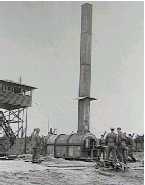
Civilians examine one of the incinerators used for burning the bodies of the victims of
the camp. Most of Belsen's barracks had to be burned down to prevent the spread of typhoid epidemics.
14 April 1945,
American troops splices the "kettle" of the Ruhr (Fieldmarschall Model).
16 April 1945,
Colditz prison camp liberated and US 7th Army will attack Neuremberg.
16 April 1945,
Battle of Berlin
Stalin has ordered a major offensive on Berlin. He doubts the validity of Eisenhower's
message of 28 March and believes the Western Allies may head for Berlin.
His instructions to his commanders are not entirely complete, neither Zhukov nor Konev being
awarded the honour of making the final assault, but these two fine Marshals have more
than two million men, 6.000 tanks, more than 5.500 aircraft and 16.000 guns available for the task.
The German defensive lines at the Oder have already been weakened by earlier attacks and
they are hopelessly short of guns, tanks and air support.
17 April 1945,
The U.S. Seventh Army capture Nuremberg, Germany.
American war correspondent Ernie Pyle is killed on Iwo Jima, a small
island of Okinawa.
24 April 1945,
The British Royal Air Force bombs Berchtesgaden, Hitler's mountain
chalet; this raid was the last significant mission over Germany by RAF Bomber Command.
25 April 1945,
American and Soviet forces meet at Torgau on the Elbe: Hitler's collapsing Reich
is cut in two.
"United Nations" formed in San Francisco.
26 April 1945,
Marshal Petain is arrested while trying to escape from France to Switzerland.
His death sentence will be commuted to life imprisonment by de Gaulle.
28 April 1945,
Benito Mussolini, Clara Petacci (his mistress), and sixteen of
Mussolini's body-guards are assassinated in the village of Giulino di
Messegra, on Lake Como, Italy.
28 April 1945,
Food shortage in Netherland. Allied American B 17's,
the Flying Fortresses and British Lancaster dropped food near Den Haag, Leiden
and Rotterdam.
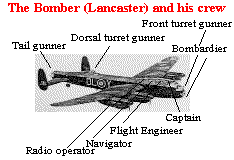
29 April 1945,
Field Marshall Sir Harold Alexander receives the German
surrender of Italy.
Adolf Hitler and Eva Braun married in hitler's bunker
in Berlin, Germany.
30 April 1945,
Adolf Hitler, Eva Braun, Goebbels and his wife commit suicide in the bunker
under the Reich Chancellery in Berlin, Germany.
Some of Hitler's last words are: "Vor allem verpflichte ich die Führung
der Nation und die Gefolgschaft zur peinlichen Einhaltung des
Rassegesetze und zum umbarmherzigen Widerstand gegen den weltvergiftiger
aller Völker, das internationale Judentum".
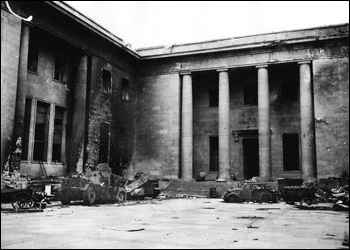
A view of the courtyard of the New Reich Chancellery, where it is reported that the
bodies of Hitler and Eva Braun, his mistress, were burned after their suicides at 3.30
p.m. Fearing what the Russians would do to his body, Hitler had left explicit
instructions to burn his body to ashes.
30 April 1945,
American forces liberate 33.000 Jews from the Dachau concentration
camp.
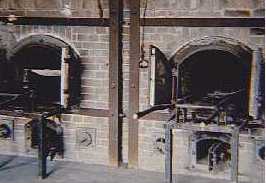
The ovens at Dachau concentration camp
where the Nazis exterminated millions of Jews, Poles, Blacks,
POW's and many other minorities.
1 May 1945,
Grand Admiral Karl Doenitz becomes the Fuehrer of the
German Reich.From 1-23 May; appearance of Government Doenitz at Flensburg.
2 May 1945,
Soviet forces capture Berlin, Germany.
15.00u; German forces (General Weidling) in Berlin surrender to the Red Army (General
Tsjoeikow).
German surrender at Italy, the Italian campaign ended;
848.000 men killed of which 534.000 Germans.
Field Marshal von Rundstedt captive.

Russian banner flying over the Reichstag as Germany falls
3 May 1945,
British forces recapture Rangoon, Burma.
3 May 1945,
Admiral Doenitz send General Von Friedeburg to General Montgomery at his
headquaters, Lüneburgerheide, to take about the unconditional
German surrender and signed at 4 May for North-West Europe.
5 May 1945,
Liberation of Concentration Camp Mauthausen, Austria.
End of German occupation of the Netherlands at 8.00 am.
6 May 1945,
German Fuehrer Doenitz surrenders Germany. All U-boats are
ordered home and all armies are ordered to cease fire.
| Summary U-boat losses of the "Kriegsmarine" during the battle of the Atlantic Ocean. |
| | | | | |
| Data | North Atl./UK waters | West Atl./USA waters |
Middle/
South Atl. | North-Sea | Northen Ice-Sea | Total |
| 3/9/39-31/5/40: | 10 | -- | -- | 11 | -- | 11 |
| 1/6/40-31/3/41: | 12 | -- | -- | -- | -- | 12 |
| 1/4/41-31/12/41: | 18 | -- | 1 | -- | -- | 19 |
| 1/1/42-31/7/42: | 4 | 11 | 1 | -- | 2 | 18 |
| 1/8/42-31/5/43: | 73 | 8 | 9 | -- | 5 | 95 |
| 1/6/43-18/9/43: | 6 | 6 | 10 | -- | 1 | 23 |
| 19/9/43-31/5/44: | 66 | 3 | 1 | -- | 14 | 84 |
| 1/6/44-8/5/45: | 73 | 10 | 2 | 4 | 15 | 104 |
| --- | --- | --- | --- | --- | --- |
| Total | 262 | 38 | 24 | 15 | 37 | 376 |
7 May 1945,
General Alfried Jodl signs the unconditional German nation surrender
document at Rheims, France, in order of the new Government Doenitz.
Seyss-Inquart arrested.

8 May 1945,
V-E Day - Victory in Europe is celebrated. It is of course the last day of the Third Reich too.
9 May 1945,
0.16u: A ratification of surrender is signed by Marshal Zhukov of the
Soviet Union and Field Marshal Wilhelm Keitel (General Stumpf and Admiral
von Friedeburg) of Germany in Berlin-Karlshorst.
Zhukov, Marshal Georgi (1896-1974)
Zhukov joined the Red Army in 1918 and made his name during the Second World War as an outstanding Royal Artillery commander,
helping in the defence of Leningrad and Moscow and planning the relief of Stalingrad.
He was responsible for the tank victory at Kursk, the breakthrough in Byelorussia and the final offensive leading to the
capture of Berlin. After the war he was Commander in Chief of the Soviet Zone of Occupation and later
Minister of Defence 1955-57 when he fell from grace and abruptly retired.
11 May 1945,
On the morning of 11 May 1945, while supporting the Okinawa invasion, Bunker Hill was hit and severely damaged by two suicide planes.
Gasoline fires flamed up and several explosions took place.
The ship suffered theloss of 346 men killed, 43 missing, and 264 wounded.
Although badly crippled she managed to return to Bremerton via Pearl Harbor.
13 May 1945,
Keitel arrested.From 4 May-14 June next persons arrested; Schacht, Frick, Frank,
von Neurath, Seyss-Inquart, Funk, Kaltenbrunner, Ley, Rosenberg, Doenitz,
Jodl, Speer, Streicher, von Schirach and von Ribbentrop.
15 May 1945,
Soviet forces discover the body of Dr. Joseph Goebbels,
German Minister of Propaganda, his wife and children. All died by
suicide.
The Allies disband the government of Fuehrer Doenitz.
23 May 1945,
End of Government Doenitz, take over by Allies.
24 May 1945,
British troops capture German Gestapo chief Heinrich
Himmler. He commits suicide upon capture by swallowing poison.
25 May 1945,
American invasionplan for Japan decided: 1 Novembre 1945 landing on Kyoesjoe,
summer 1946 landing on the plain of Tokyo.
26 May 1945,
Tokyo, Japan is fire bombed by American bombers. The city
burns, uncontrolled, for two days.
Chinese take Foochow (18 May) and Nanning (26 May).
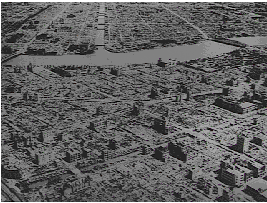
A aerial view of the industrial part of Tokyo showing extensive damage done by Allied saturation raids
5 June 1945,
The Four Powers (the United States, Britain, the Soviet Union,
and France) sign the declaration of German defeat.
10 June 1945,
British troops capture German Foreign Minister Joachim von
Ribbentrop.
12 June 1945,
Mass suicides among the Japanese forces on Okinawa (Oruku region),
indicates the hopelessness of Japanese situation.
18 June 1945,
General Dwight D. Eisenhower addresses a joint session of
the U.S. Congress.
21 June 1945,
U.S. Army and Marines (with 7th Infantry div.) complete the capture of Okinawa;
112.000 Japanese and 12.500 American are killed, 36.000 wounded.
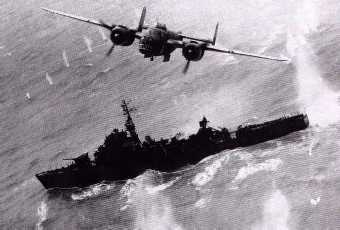
A B-25 bomber drops a 5000-pound bomb on a Japanese frigate off the Indo-China coast.
Japanese merchant ships, gross tons.
| _______________________________________________ |
|
|
| Year |
Built |
Sunk |
| _________________________________________________ |
|
|
| 1942 |
260.059 |
971.855 |
| 1943 |
769.085 |
1.661.791 |
| 1944 |
1.699.203 |
5.557.976 |
| 1945 (to Aug) |
559.563 |
1.537.484 |
| __________________________________________________ |
|
|
| To make war Japan needed ships. At the beginning of the war Japanese merchant ships
were totalled about 6 million tons, at the end was below 2 million. |
|
|
26 June 1945,
Fifty nations meet in San Francisco, California (USA) and
sign the World Security Charter formally establishing the United
Nations.
29 June 1945,
President Truman approves plans for invasion of Japan at 1 November 1945,
with further landings in the spring 1946.
30 June 1945,
Chinese forces invade Indo-China.
4 July 1945,
General Douglas MacArthur announces the liberation of the
Philippines.
5 July 1945,
Labour Party lead Clement Attlee becomes Prime Minister of
Great Britain (England).
16 July 1945,
The first atomic device is exploded at Alamogordo (Los Alamos), New
Mexico (USA).
17 July 1945,
(till 2 August). The Potsdam Conference.
21 July 1945,
The U.S. delivers a final ultimatum to the Japanese, quit the
war or face total destruction.
24 July 1945,
At the Potsdam Conference in defeated Germany,
President Truman told Stalin only that the U.S. "had a new weapon of
unusual destructive force."
29 July 1945,
Japan formally rejects the U.S. ultimatum.
6 August 1945,
|
The world's first atomic bomb (Uranium), Little Boy, is dropped on Hiroshima,
Japan, from the Enola Gay, a B-29 bomber piloted by
Colonel Tibbets of the 509th Composite Group, the first military unit in the
history to drop a nuclear bomb in combat. One minute after explosion were 66.000 killed and 69.000 wounded.
|
|
| |
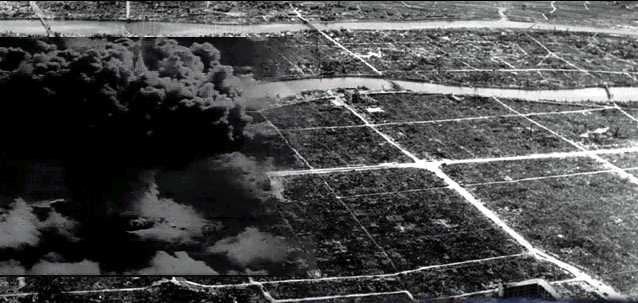
8 August 1945,
Japan tries to persuade the Soviets to mediate
surrender negotiations. Molotov cancel's the meeting, then
The Soviet Union declares war on Japan. Soviet forces
invade Manchuria and North-Korea.
9 August 1945,
Leaflet dropping, and warnings to Japan by Radio Saipan.
The world's second (and last) atomic bomb (Plutonium), Fat Man, is
dropped on Nagasaki, Japan, from a B-29 piloted by Major Charles W.
Sweeney. One minute after explosion were 39.000 killed and 25.000 wounded.
10 August 1945,
Soviet force invade Korea and Sakhalin Island.
14 August 1945,
Emperor Hirohito announces the Japan defeat to his
people. Japan accepts an unconditional surrender. The fear of more atomic weapon
attacks and the certainty of land defeat by the Soviets have combined to secure the complete surrender.
19 August 1945,
Japanese surrender delegations arrives at General
MacArthur's Philippine headquarters to receive instructions.
23 August 1945,
U.S. President Harry S. Truman halts all Lend-Lease
shipments.
29 August 1945,
The Allies name 24 Nazi and Prussian officers to face war
crimes trials in Nuremberg, Germany.
30 August 1945,
General MacArthur sets-up his headquarters in Yokohama,
Japan.
Japanese surrendered in Burma, Major Wako Lisanon, Staff Officer of the Japanese 28th Army, hands his sword to Lieutenant
Colonel O C Smyth, commanding 1/10 Gurkha Regiment. There were many such ceremonies as units in the field surrendered.
| Development of the American Forces from 1941-1945. | | | |
| Officers | Men | Total |
| 1941 | 99.536 | 1.341.462 | 1.460.998 |
| 1942 | 206.422 | 2.867.762 | 3.074.184 |
| 1943 | 579.576 | 6.413.526 | 6.993.102 |
| 1944 | 776.980 | 7.215.888 | 7.992.868 |
| 1945 | 991.663 | 7.374.710 | 8.266.373 |
2 September 1945,
Japanese Foreign Minister Mamoru Shigemitsu signs
the instrument of surrender aboard the battleship U.S.S. Missouri in
Tokyo Bay, Japan.
End of World War II.
| Mobilized strengths armed services. | |
| Country | | Mobilized strengths |
| UK | | 5.000.000 |
| India | | 2.150.000 |
| USA | | 11.700.000 |
| USSR | | 11.500.000 |
| France | | 5.000.000 |
| Germany | | 9.500.000 |
| Italy | | 4.000.000 |
| Japan | | 4.000.000 |
World War II was a war of mass armies. For the USSR and Germany take in account
at least 6 million (USSR) and 4 million (Germany) more served before becoming casualties.
20 November 1945,
The Nuremberg Trials begin with 21 leading Nazi officials in the dock including
Goering, Donitz, Raeder, Jodl and Keitel. The event discloses to the world the horror of the Nazi regime;
Rudolf Hess, who had been an SS- Obergruppenfuhrer, gives appalling details of the systematic mass murder at Auschwitz.
The trails continue until October 1946.
More items links for the same subjects:

[Welcome]-
[Introduction]-
[1889-1930]-
[1930-1938]-
[1939]-
[1940]-
[1941]-
[1942]-
[1943]-
[1944]-
[1945]-
[Museum]-
[WWII HomePages]-
[Secret]-
[Related]-
[Postscript]-
[Message-board]-
[Comment]-
[Guest-book]-
[Webrings]-
[Trade]
Page maintained and created by Wilfried Braakhuis.
Copyright © 1997-2007 Wilfried Braakhuis. All rights reserved.
This page, and all contents, logos and images are Copyright © 1997-2007, and
protected by Elite Engineer Publishing, Netherlands
law for The World at War.



















![]()